My chalet at Brameloup is surrounded by forest, with different characteristics on each part of my 8,700 square meter property. I maintain a few meadow clearings around my chalet, and have build trails that give me access to all parts of the forest. I always spend some time walking the trails I have built to enjoy being close to nature in all seasons. Observing the life around me; enjoying the ever-changing colours, patterns, shapes and wonders; feeling the sun, breeze, rain or snow on my skin; listening to the birds singing (and even hearing the earthworms clearing their burrows after a rain), make me feel an intimate part of nature. There is a spiritual dimension in our contact with nature that shows the greatness in what surrounds us, and teaches us humility at the same time. There are always new discoveries (see nature page and the four seasonal pages: spring, summer, fall, winter). This page gives a detailed description of my forest. For events in and around my forest, see my Life at Brameloup page, and for my outside work in the garden and forest, see my activities page.
THE FOREST
My own property stretches along 200 meters about half way up the slope that goes steeply down to the Usses River. The eastern end of the property, beyond the rural track or path to Signy that cuts diagonally through my land, drops down steeply in a ravine to the Brameloup intermittent stream, with tall trees like a natural cathedral. Many of the trees are Robinia (false acacia) very resistant to rot, so many fallen tree trunks bridge the ravine. The lower meadow is also below the track on the north side. Above the track beyond a band of forest, the upper meadow rises steeply to my lawn and chalet. The long strip of land to the west is forested, with dense oak forest giving way to a more open beech forest ending with the massive badger burrows at the west end of my property, with dense forest above and forest and a small abandoned pasture below. I have made trails through the forest so that I can walk all through it. Here is a description of my land and the beauty of nature from East to West.
The Brameloup ravine and stream, eastern forest
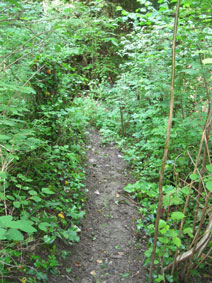 .
. 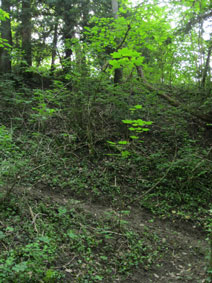 .
. 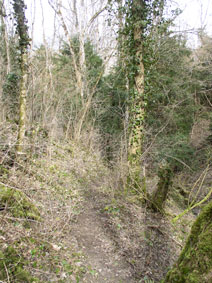 .
. 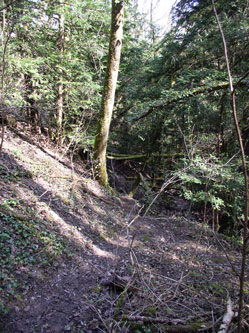
Trail into the ravine in summer; trail down the steep slope, with the lower meadow above; trail down the ravine in winter
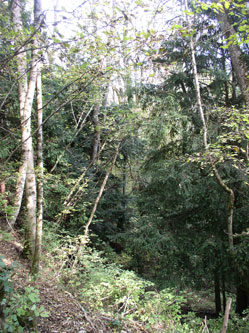 .
. 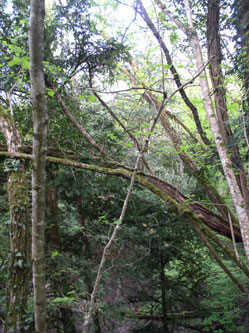 .
. 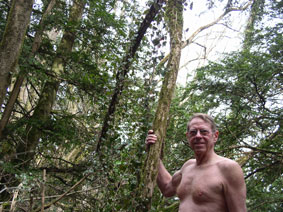
Ravine forest; tall trees in the ravine; me among the trees
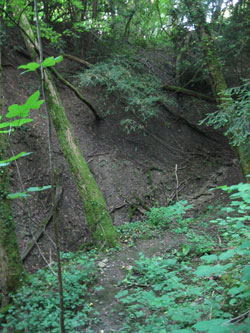 .
. 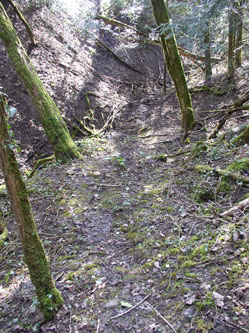 .
. 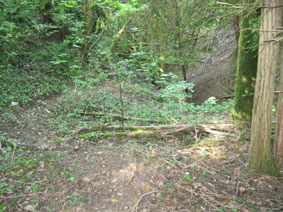
Branch trail along the level area to the stream in spring and winter; trail to the relatively level area in the upper ravine
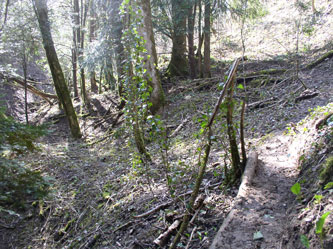 .
. 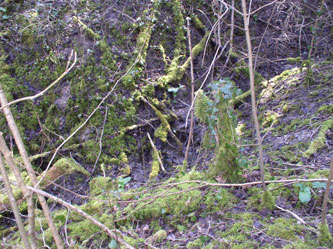 .
. 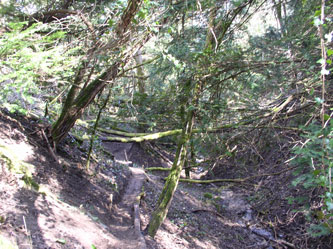
Relatively level area in the upper ravine; moss-covered logs along the stream bed; looking down the ravine from the level area with the lower trail in the middle
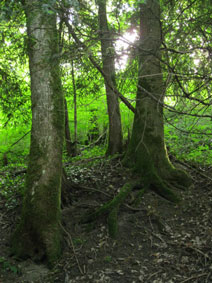 .
. 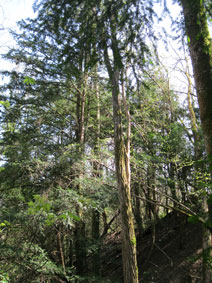 .
. 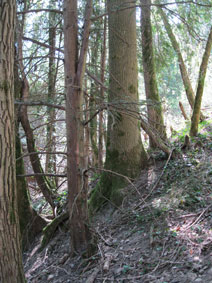 .
. 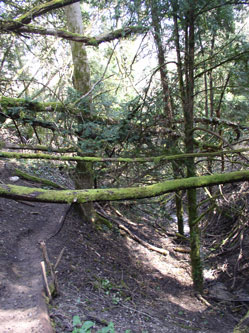
Some of the large trees in the ravine; vertical and horizontal tree trunks give a unique impression, and require ducking under when walking along the trail
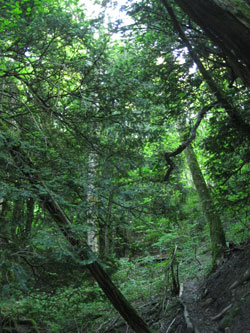 .
. 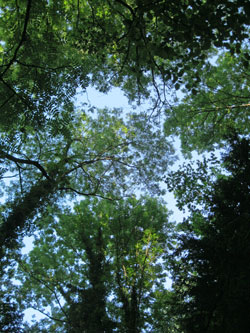 .
. 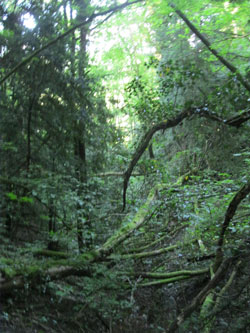
The ravine is like a green cathedral with an over-arching canopy when looking up, and rays of sunlight
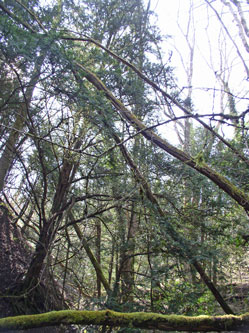 .
. 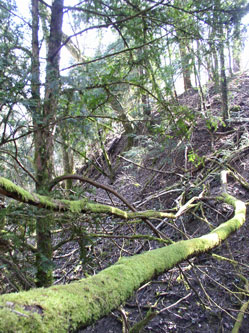 .
. 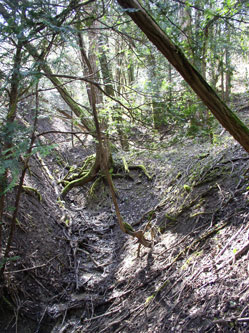
The Robinia (false acacia) trees are very resistant to rot, so the fallen tree trunks reach across the ravine; the upper Brameloup stream with level area behind the large tree
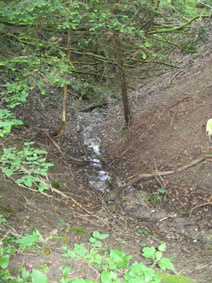 .
. 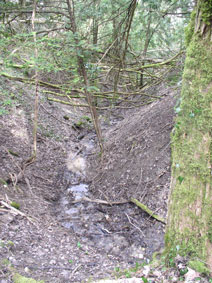 .
. 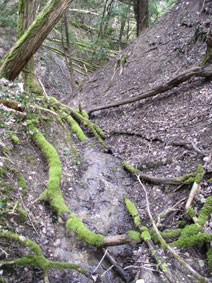 .
. 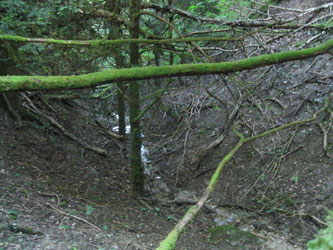
Brameloup stream with water in winter and spring
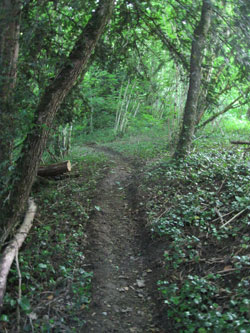 .
. 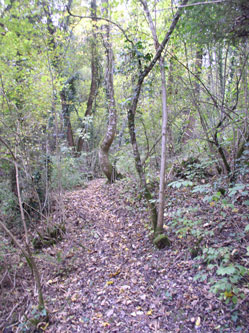 .
. Trail along the upper edge of the ravine
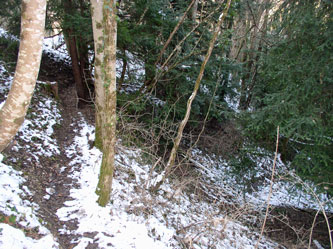 .
. 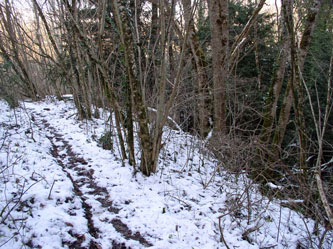 .
. 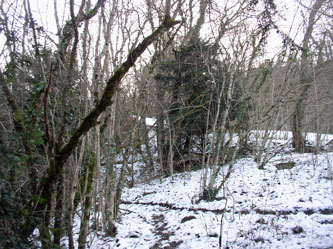
Second trail along the upper edge of the ravine to the northern edge of my property; from the top of the ravine, my chalet can barely be seen through the trees even in winter
The northernmost corner of my property down to the stream is so steep that I only went there for the first time in 2014 by following the stream bed and climbing up by pulling myself from tree to tree, so I decided to build a trail down to the stream, and then up the ravine bottom (see trail making on the activities page). I can now walk down the ravine bottom from the upper end, climb up the switchbacks at the bottom end of my land to the lower meadow, and return along the trail that follows the upper ravine slope.
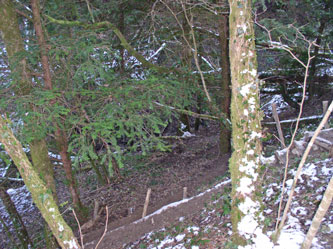 .
. 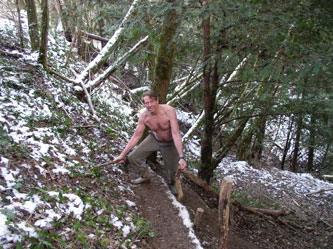 .
. 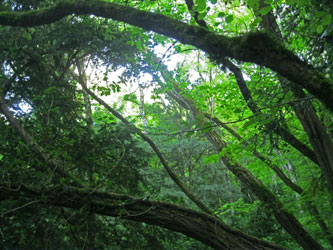
Looking down from near the top of the ravine; me on the switchbacks at the northern edge of my property; canopy over the switchbacks
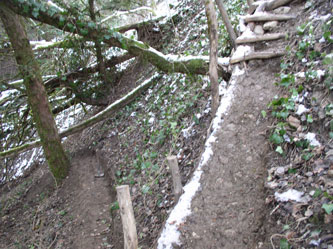 .
. 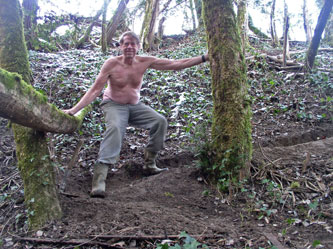 .
. 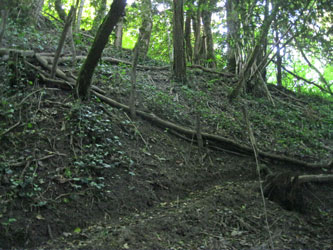
The trail required some complex engineering with 7 switchbacks and supporting logs; now I can finally go up and down the slope; looking up at the switchbacks
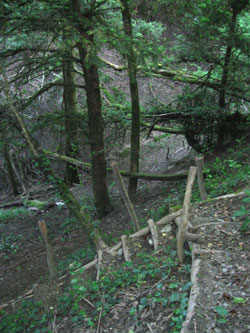 .
.
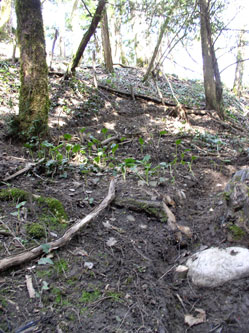 .
. 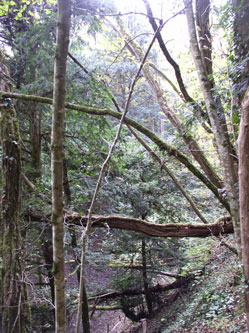
Stairs on the steeper switchbacks; the switchbacks; another big tree fell over the trail down in 2015, but was too high to block it until 2016
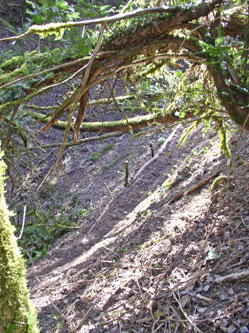 .
. 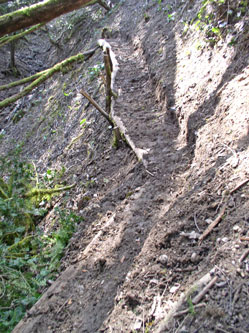 .
. 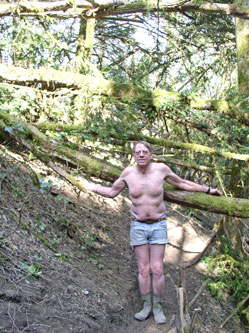
Looking down on the trail along the ravine bottom; trail up the ravine bottom; me on the trail with remaining horizontal tree trunks
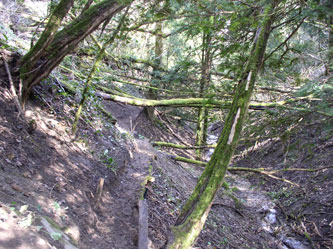 .
. 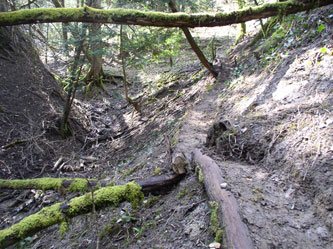 .
. 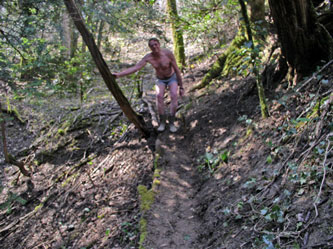
Trail along the ravine bottom looking down; and up; me descending the lower trail
Beyond the lawn, as my property drops down from the chalet, there are upper and lower meadows divided by the rural track that crosses my land diagonally, with the ravine with the Brameloup stream to the East, and my forest mostly to the West. The meadows are full of orchids, lilies and other wildflowers (see nature, spring and summer pages), so I mow them in mid-summer after the orchids are gone and before the autumn crocus, and I try to keep the forest from encroaching by clearing the borders and removing tree seedlings. At the bottom of my land, a footpath goes down the steep slope across the Brameloup stream to the Usses River at the ford where my water pipe crosses the river.
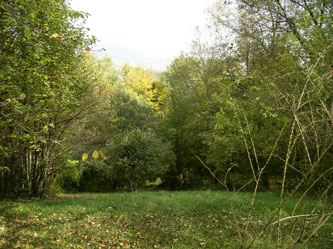 .
. 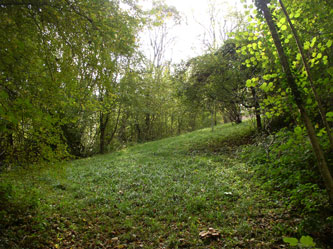 .
. 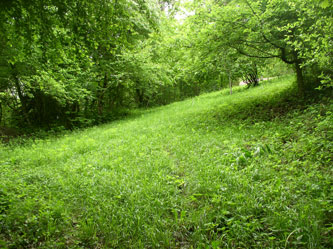
The upper meadow looking down; and up from the bottom
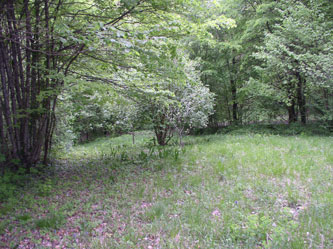 .
. 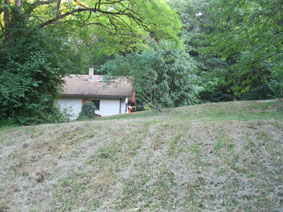 .
. 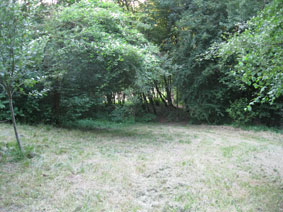
Upper meadow in spring; just mowed in mid-summer: from the top; looking up to the chalet; bottom part of the upper meadow
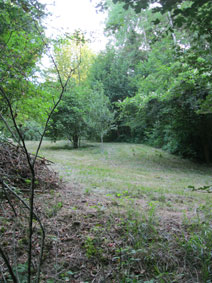 .
. 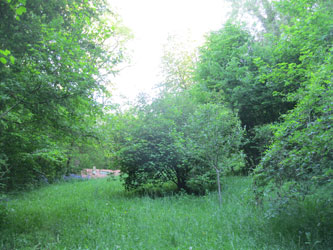
Looking up at the upper meadow from the path; looking up the upper meadow in spring
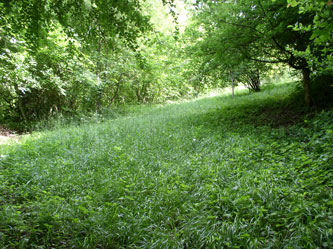 .
. 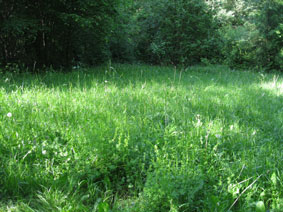
Meadow before mowing in summer
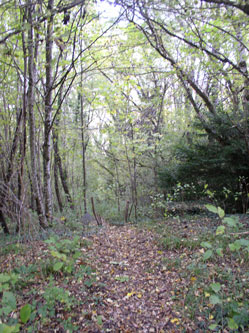 .
.
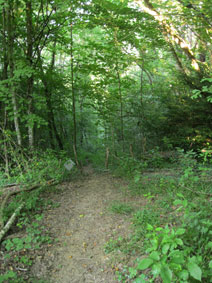 .
. 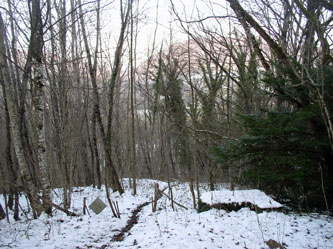
Footpath down from the lower meadow at the edge of my property to the Usses river in fall, summer and winter
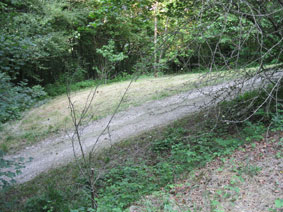 .
. 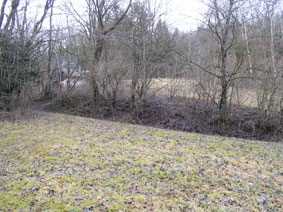 .
. 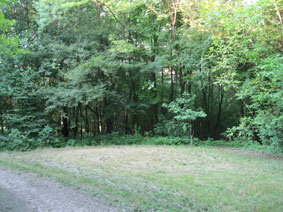
Looking down at the lower meadow across the rural track from the upper meadow; lower and upper meadows in winter: lower meadow after mowing
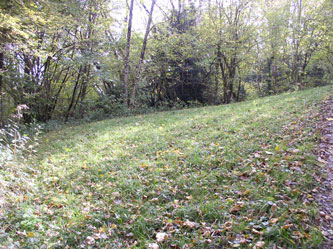 .
. 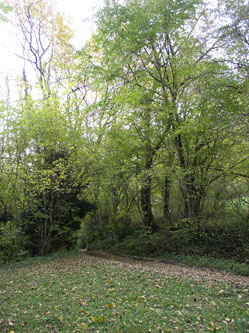 .
.
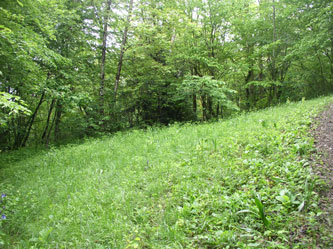
The lower meadow in autumn; lower meadow and rural track; lower meadow in spring
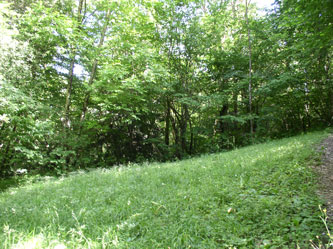 .
.
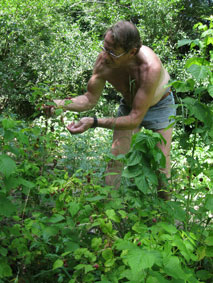
Lower meadow in summer; I often stop to pick wild strawberries, blackberries and raspberries
Central forest
The central forest of large oaks, ash, yew, walnut and false acacia runs along a steep slope from upper and lower areas that are more level, and may have been farmed in the past. It has an upper access trail from the top of my property behind the vegetable garden, a middle trail from the top of the upper meadow which continues along the middle of the slope all the way to the far west end of my land, a lower trail along the bottom of the steepest slope which joins the middle trail beyond the central forest, and another that loops from the far western end down near the bottom boundary of my property and back to the track at the bottom of my upper meadow.
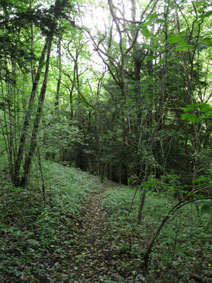 .
. 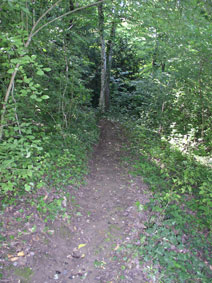 .
. 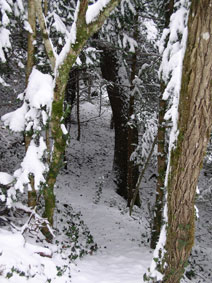 .
. 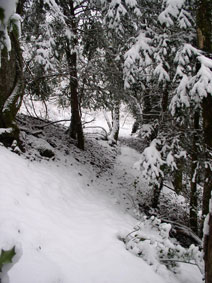
Upper trail beyond the vegetable garden to the central forest; middle trail from upper meadow to central forest in summer and winter
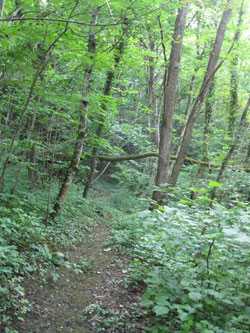 .
. 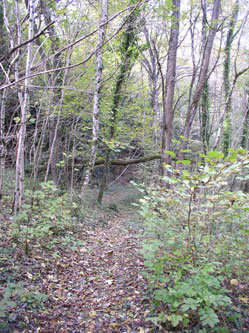 .
. 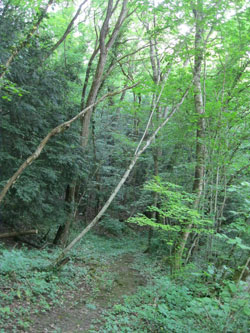
Lower middle trail through the central forest below the slope (to the left) looking west
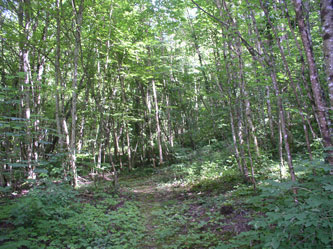 .
. 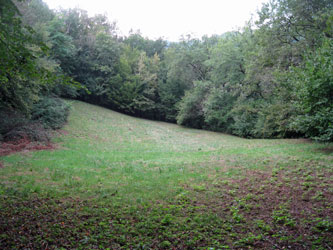
The lower central forest is relatively level; the pasture below my property, which is to the left of the picture
Western forest
To access the western forest, there is a middle trail that goes from the upper meadow diagonally down the slope and through to the badger dens at the limit of my property. It is joined from above by an upper trail with switchbacks from behind the vegetable garden, and further west branches to an 8o meter upper trail along the top boundary of my land above the badger dens, where there are some very large trees. Another branch trail at the same point goes east as the lower middle trail below the steep slope to the bottom of the upper meadow. From the west end, the lower trail near the bottom of the central forest returns above the neighbouring pasture to the meadow and road. I have added a ramp and short loop to the bottom western corner of my property, making four trails with connections crossing the western and central forest.
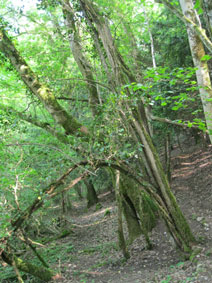 .
. 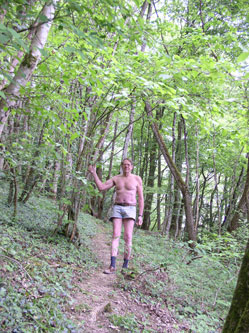 .
. 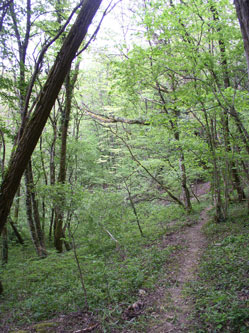
Looking east from the western forest at the junction of lower middle and middle trails; me on the middle trail; middle trail
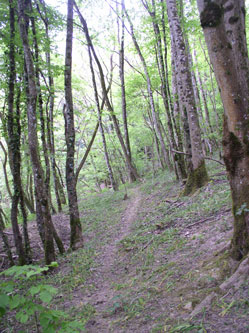 .
. 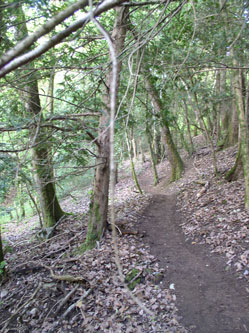 .
. 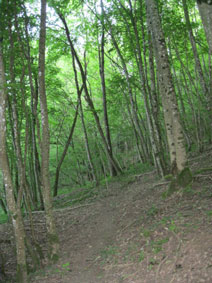
Middle trail in western beech forest
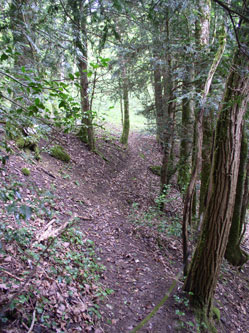 .
. 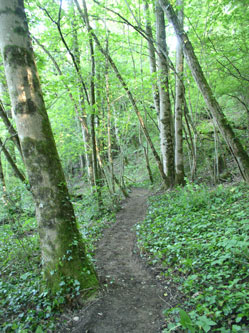 .
. 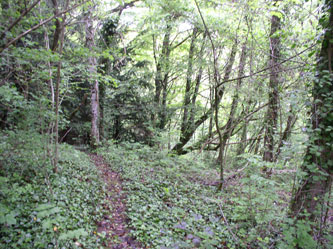
Upper trail through the western forest
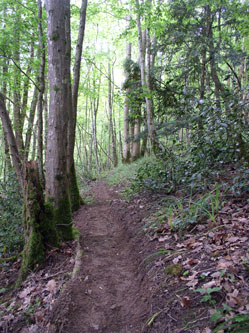 .
. 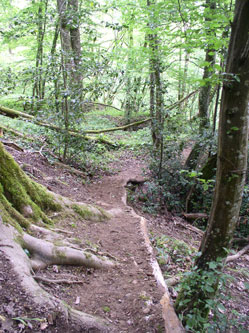 .
. 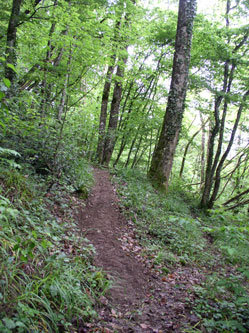
Upper trail through the western forest
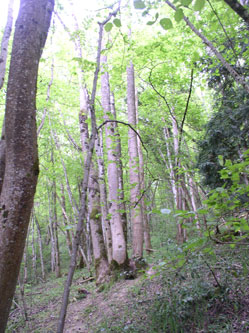 .
. 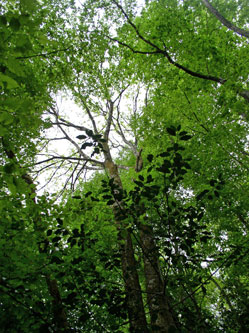 .
. 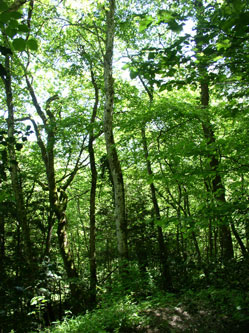
Upper western forest; western forest canopy; western forest
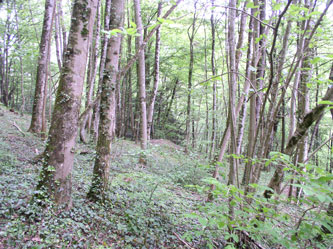 .
. 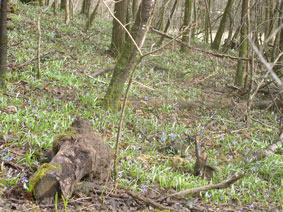 .
. 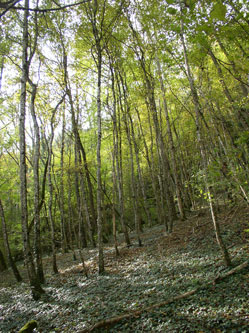
Upper western forest; carpet of Scylla lilies in early spring; looking up through the beech forest
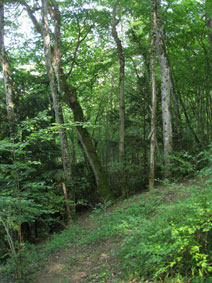
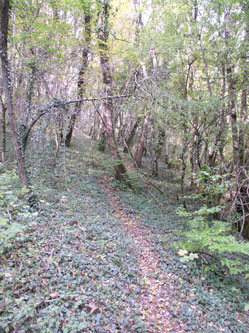
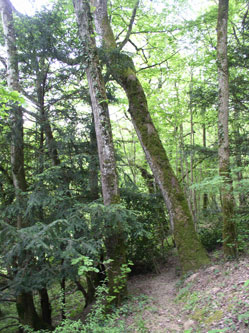

Bottom boundary trail in the western forest
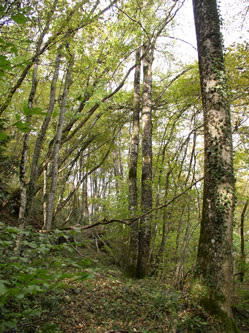 .
. 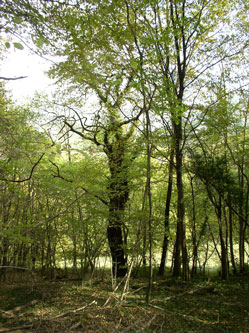 .
. 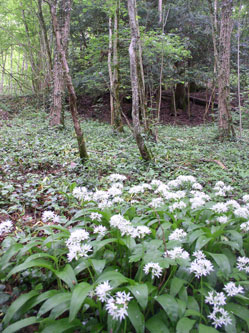
Forest at western end of my property; old oak at the bottom of the western forest; bear garlic (ail des ours) below the western forest
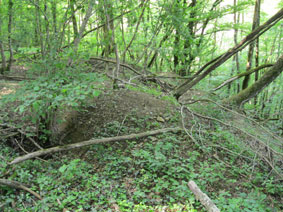 .
. 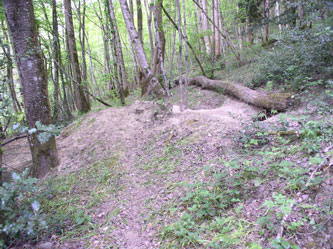 .
. 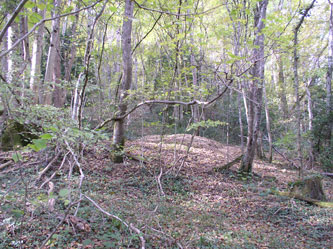 .
. Badger dens at end of western forest; middle trail through the badger dens
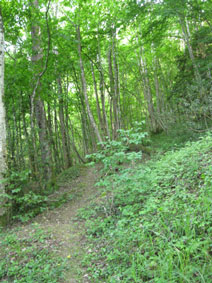 .
. 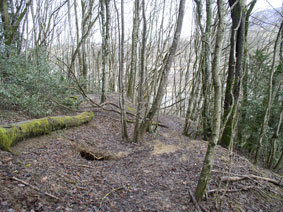 .
. 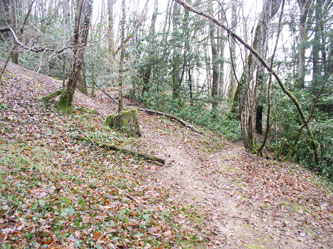
In summer, the western beech forest along the middle trail is green; in winter, it is more open; my trail goes to the right, the trail to the left was made by badgers
CLIMATE CHANGE AND INVASIVE SPECIES
I have observed over the last 20 years how much more ivy there is now in my forest. A recent article in New Scientist reports that ivy is multiplying in Europe's forests as the climate warms. Sometimes there is so much ivy in a tree that it looks alive even if it is dead. Some trees fall over because the ivy in their branches becomes so heavy and wind-resistant. The ivy ground cover also crowds out the meadow grasses and many wildflowers like the orchids that used to be common in my meadows, so there is an impact on biodiversity, as with many invasive species.
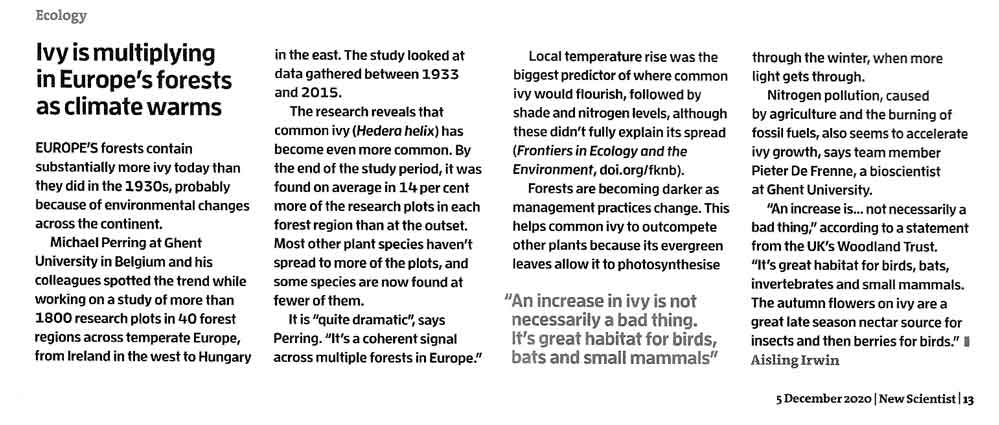
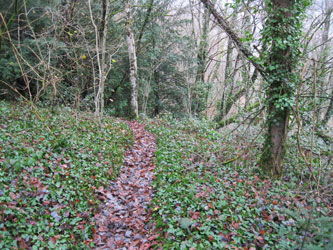 .
. 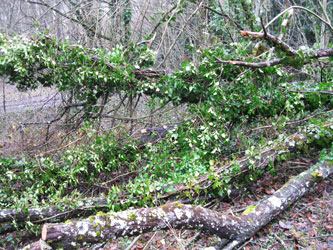 .
. 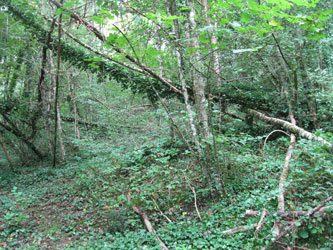
Ivy along a trail; on a fallen tree; bringing down trees in the forest
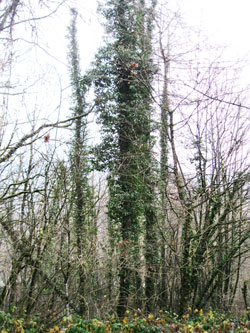 .
. 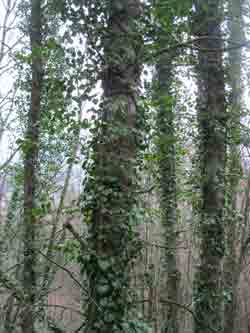 .
. 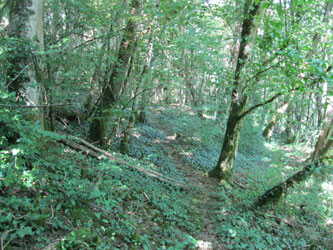
Ivy climbing trees; clasping a tree; carpeting the forest
Ash dieback
Ash trees are a major component of my forest, but a fungal disease introduced from China some years ago is spreading across Europe, causing Ash trees to lose their leaves, and see their branches die back, ultimately killing them. The young ash trees regrowing on part of my property have died first, and now many of the biggest trees are losing their leaves prematurely. This will have a severe impact on the composition of my forest, and the dead trees will be a danger when they fall, as they already have at the bottom of my property.
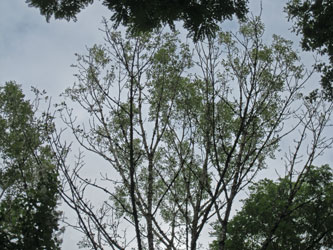 .
. 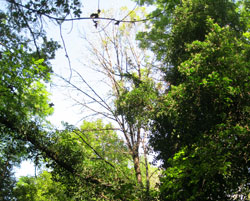 .
. 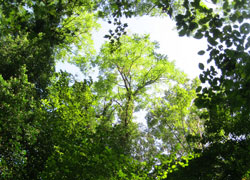
Treetops of Ash trees losing their leaves; a healthy tree for comparison (right, in centre)
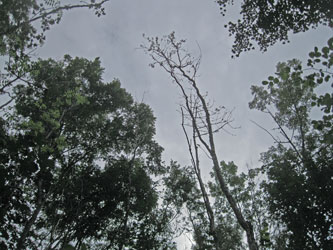 .
. 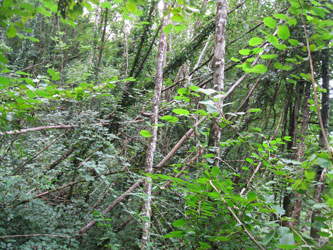
Ash dieback; many fallen Ash trees in the lower forest